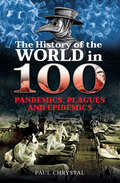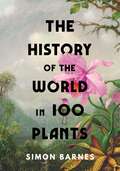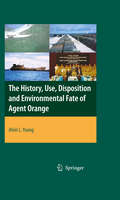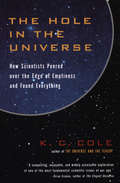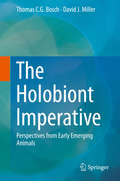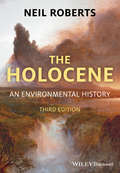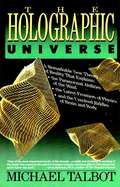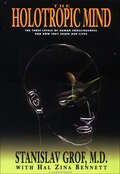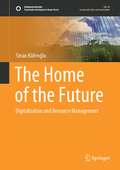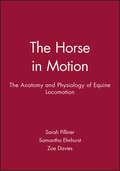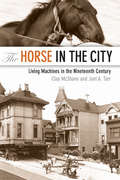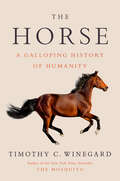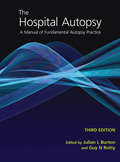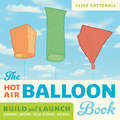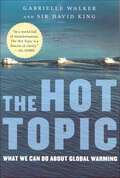- Table View
- List View
The History of the World in 100 Pandemics, Plagues and Epidemics
by Paul ChrystalThis &“timely, topical, informative [and] exceptionally well written&” history explores the impact of disease from prehistoric plagues to Covid-19 (Midwest Book Review). Historian Paul Chrystal charts how human civilization has grappled with successive pandemics, plagues, and epidemics across millennia. Ranging from prehistory to the present day, this volume begins by defining what constitutes a pandemic or epidemic, taking a close look at 20 historic examples: including cholera, influenza, bubonic plague, leprosy, measles, smallpox, malaria, AIDS, MERS, SARS, Zika, Ebola and, of course, Covid-19. Some less well-known, but equally significant and deadly contagions such as Legionnaires&’ Disease, psittacosis, polio, the Sweat, and dancing plague, are also covered. Chrystal provides comprehensive information on each disease, including epidemiology, sources and vectors, morbidity, and mortality, as well as governmental and societal responses, and their political, legal, and scientific consequences. He sheds light on how public health crises have shaped history—particularly in the realms of medical and scientific research and vaccine development. Chrystal also examines myths about infectious diseases, and the role of the media, including social media.
The History of the World in 100 Plants
by Simon BarnesFrom the author of The History of the World in 100 Animals, a BBC Radio Four Book of the Week, comes an inspirational new book that looks at the 100 plants that have had the greatest impact on humanity, stunningly illustrated throughout. As humans, we hold the planet in the palms of ours hands. But we still consume the energy of the sun in the form of food. The sun is available for consumption because of plants. Plants make food from the sun by the process of photosynthesis; nothing else in the world can do this. We eat plants, or we do so at second hand, by eating the eaters of plants. Plants give us food. Plants take in carbon dioxide and push out oxygen: they give us the air we breathe, direct the rain that falls and moderate the climate. Plants also give us shelter, beauty, comfort, meaning, buildings, boats, containers, musical instruments, medicines and religious symbols. We use flowers for love, we use flowers for death. The fossils of plants power our industries and our transport. Across history we have used plants to store knowledge, to kill, to fuel wars, to change our state of consciousness, to indicate our status. The first gun was a plant, we got fire from plants, we have enslaved people for the sake of plants. We humans like to see ourselves as a species that has risen above the animal kingdom, doing what we will with the world. But we couldn&’t live for a day without plants. Our past is all about plants, our present is all tied up with plants; and without plants there is no future. From the mighty oak to algae, from cotton to coca here are a hundred reasons why.
The History, Use, Disposition and Environmental Fate of Agent Orange
by Alvin Lee YoungFor almost four decades, controversy has surrounded the tactical use of herbicides in Southeast Asia by the United States military. Few environmental or occupational health issues have received the sustained international attention that has been focused on Agent Orange, the major tactical herbicide deployed in Southern Vietnam. With the opening and establishment of normal relations between the United States and the Socialist Republic of Vietnam in 1995, the time has come for a thorough re-examination of the military use of Agent Orange and other "tactical herbicides" in Southern Vietnam, and the subsequent actions that have been taking place since their use in Vietnam. The United States Department of Defense has had the major role in all military operations involving the use of tactical herbicides, including that of Agent Orange. This included the Department's purchase, shipment and tactical use of herbicides in Vietnam, its role in the disposition of Agent Orange after Vietnam, its role in conducting long-term epidemiological investigations of the men of Operation RANCH HAND, and its sponsorship of ecological and environmental fate studies. This book was commissioned by The Office of the Deputy Under Secretary of Defense (Installations and Environment) with the intent of providing documentation of the knowledge on the history, use, disposition and environmental fate of Agent Orange and its associated dioxin.
The Hive: The Story of the Honeybee and Us
by Bee WilsonEver since men first hunted for honeycomb in rocks and daubed pictures of it on cave walls, the honeybee has been seen as one of the wonders of nature: social, industrious, beautiful, terrifying. No other creature has inspired in humans an identification so passionate, persistent, or fantastical.The Hive recounts the astonishing tale of all the weird and wonderful things that humans believed about bees and their "society" over the ages. It ranges from the honey delta of ancient Egypt to the Tupelo forests of modern Florida, taking in a cast of characters including Alexander the Great and Napoleon, Sherlock Holmes and Muhammed Ali.The history of humans and honeybees is also a history of ideas, taking us through the evolution of science, religion, and politics, and a social history that explores the bee's impact on food and human ritual. In this beautifully illustrated book, Bee Wilson shows how humans will always view the hive as a miniature universe with order and purpose, and look to it to make sense of their own.
The Hole in the Universe: How Scientists Peered over the Edge of Emptiness and Found Everything
by K. C. Cole&“A compelling, enjoyable, and widely accessible exploration of one of the most fundamental scientific issues of our age&” (Brian Greene, author of The Elegant Universe). In The Hole in the Universe, an award-winning science writer &“provides an illuminating slant on physics and mathematics by exploring the concept of nothing&” (Scientific American). Welcome to the world of cutting-edge math, physics, and neuroscience, where the search for the ultimate vacuum, the point of nothingness, the ground zero of theory, has rendered the universe deep, rich, and juicy. Every time scientists and mathematicians think they have reached the ultimate void, something new appears: a black hole, an undulating string, an additional dimension of space or time, repulsive anti-gravity, universes that breed like bunnies. Cole&’s exploration at the edge of everything is &“as playfully entertaining as it is informative&” (San Jose Mercury News). &“A strong and sometimes mind-blowing introduction to the edges of modern physics.&” —Salon.com &“Comprising an expansive set of topics from the history of numbers to string theory, the big bang, even Zen, the book&’s chapters are broken into bite-sized portions that allow the author to revel in the puns and awkwardness that comes with trying to describe a concept that no one has fully grasped. It is an amorphous, flowing, mind-bending discussion, written in rich, graceful prose. As clear and accessible as Hawking&’s A Brief History of Time, this work deserves wide circulation, not just among science buffs.&” —Publishers Weekly, starred review &“Here we have the definitive book about nothing, and who would think that nothing could be so interesting . . . not only accessible but compelling reading.&” —St. Louis Post-Dispatch
The Holistic Dog Book: Canine Care for the 21st Century
by Denise FlaimFrom the Book Jacket: "This book is an important contribution to improving the health, well-being and care of our closest animal companion, the dog... No one with a dog should bewithout this book." - From the Foreword by Dr. Michael W. Fox The Holistic Dog Book addresses your whole dog and all the ways you can bring a more natural approach to your dog's care. Whether you're interested in essential oils, homeopathy, natural diets, herbal remedies, acupuncture, massage or emotionally satisfying training, you'll find what you need to make well-informed decisions about what's right for the both of you. DENISE FLAIM is the companion-animal columnist for Newsday. With her naturally reared champion Rhodesian Ridgebacks, she is involved in showing, lure coursing, obedience and therapy dog work. A HOWELL DOG BOOK OF DISTINCTION
The Holobiont Imperative
by Thomas C. G. Bosch David J. MillerThisbook examines how the growing knowledge of the huge range of animal-bacterialinteractions, whether in shared ecosystems or intimate symbioses, isfundamentally altering our understanding of animal biology. Individuals fromsimple invertebrates to human are not solitary, homogenous entities but consistof complex communities of many species that likely evolved during a billionyears of coexistence. Defining the individual microbe-host conversations inthese consortia, is a challenging but necessary step on the path tounderstanding the function of the associations as a whole. The hologenometheory of evolution considers the holobiont with its hologenome as a unit ofselection in evolution. This new view may have profound impact on understandinga strictly microbe/symbiont-dependent life style and its evolutionaryconsequences. It may also affect the way how we approach complex environmentaldiseases from corals (coral bleaching) to human (inflammatory bowel diseaseetc). The book is written for scientists as well as medically interestedpersons in the field of immunobiology, microbiology, evolutionary biology,evolutionary medicine and corals.
The Holocene and Anthropocene Environmental History of Mexico: A Paleoecological Approach on Mesoamerica
by Nuria Torrescano-Valle Gerald A. Islebe Priyadarsi D. RoyThis book provides essential information on Mexico’s Holocene and Anthropocene climate and vegetation history. Considering the geography of Mexico – which is home to a variety of climatic and environmental conditions, from desert and tropical to high mountain climates – this book focuses on its postglacial paleoecology and paleoclimatology. Further, it analyses human intervention since the middle Holocene as a major agent of environmental change. Offering a valuable tool for understanding past climate change and its relationship with present climate change, the book is a must-read for botanists, ecologists, palaeontologists and graduate students in related fields.
The Holocene: An Environmental History
by Neil RobertsThe Holocene provides students, researchers and lay-readers with the remarkable story of how the natural world has been transformed since the end of the last Ice Age around 15,000 years ago. This period has witnessed a shift from environmental changes determined by natural forces to those dominated by human actions, including those of climate and greenhouse gases. Understanding the environmental changes - both natural and anthropogenic - that have occurred during the Holocene is of crucial importance if we are to achieve a sustainable environmental future. Revised and updated to take full account of the most recent advances, the third edition of this classic text includes substantial material on the scientific methods that are used to reconstruct and date past environments, as well as new concepts such as the Anthropocene. The book is fully-illustrated, global in coverage, and contains case studies, a glossary and more than 500 new references.
The Hologenome Concept: Human, Animal and Plant Microbiota
by Eugene Rosenberg Ilana Zilber-RosenbergGroundbreaking research over the last 10 years has given rise to the hologenome concept of evolution. This concept posits that the holobiont (host plus all of its associated microorganisms) and its hologenome (sum of the genetic information of the host and its symbiotic microorganisms), acting in concert, function as a unique biological entity and therefore as a level of selection in evolution. All animals and plants harbor abundant and diverse microbiota, including viruses. Often the amount of symbiotic microorganisms and their combined genetic information far exceed that of their host. The microbiota with its microbiome, together with the host genome, can be transmitted from one generation to the next and thus propagate the unique properties of the holobiont. The microbial symbionts and the host interact in a cooperative way that affects the health of the holobiont within its environment. Beneficial microbiota protects against pathogens, provides essential nutrients, catabolizes complex polysaccharides, renders harmful chemicals inert, and contributes to the performance of the immune system. In humans and animals, the microbiota also plays a role in behavior. The sum of these cooperative interactions characterizes the holobiont as a unique biological entity. Genetic variation in the hologenome can be brought about by changes in either the host genome or the microbial population genomes (microbiome). Evolution by cooperation can occur by amplifying existing microbes, gaining novel microbiota and by acquiring microbial and viral genes. Under environmental stress, the microbiome can change more rapidly and in response to more processes than the host organism alone and thus influences the evolution of the holobiont. Prebiotics, probiotics, synbiotics and phage therapy are discussed as applied aspects of the hologenome concept.
The Hologenome Concept: Human, Animal and Plant Microbiota
by Eugene Rosenberg Ilana Zilber-RosenbergGroundbreaking research over the last 10 years has given rise to the hologenome concept of evolution. This concept posits that the holobiont (host plus all of its associated microorganisms) and its hologenome (sum of the genetic information of the host and its symbiotic microorganisms), acting in concert, function as a unique biological entity and therefore as a level of selection in evolution.All animals and plants harbor abundant and diverse microbiota, including viruses. Often the amount of symbiotic microorganisms and their combined genetic information far exceed that of their host. The microbiota with its microbiome, together with the host genome, can be transmitted from one generation to the next and thus propagate the unique properties of the holobiont. The microbial symbionts and the host interact in a cooperative way that affects the health of the holobiont within its environment. Beneficial microbiota protects against pathogens, provides essential nutrients, catabolizes complex polysaccharides, renders harmful chemicals inert, and contributes to the performance of the immune system. In humans and animals, the microbiota also plays a role in behavior. The sum of these cooperative interactions characterizes the holobiont as a unique biological entity. Genetic variation in the hologenome can be brought about by changes in either the host genome or the microbial population genomes (microbiome). Evolution by cooperation can occur by amplifying existing microbes, gaining novel microbiota and by acquiring microbial and viral genes. Under environmental stress, the microbiome can change more rapidly and in response to more processes than the host organism alone and thus influences the evolution of the holobiont. Prebiotics, probiotics, synbiotics and phage therapy are discussed as applied aspects of the hologenome concept.
The Holographic Universe
by Michael TalbotThese relatively new data are of such far-reaching relevance that they could revolutionize our understanding of the human psyche, of psychopathology, and of the therapeutic process. Some of the observations transcend in their significance the framework of psychology and psychiatry and represent a serious challenge to the current Newtonian-Cartesian paradigm of Western science. They could change drastically our image of human nature, of culture and history, and of reality.
The Holotropic Mind: The Three Levels of Human Consciousness and How They Shape Our Lives
by Hal Zina Bennett Stanislav Grof“An exceptionally clear and readable introduction to the evolving psychology of the spirit, transpersonal psychology” from the renowned psychiatrist (Charles T. Tart, PhD, author of Mind Science).A turning point in psychology and human history . . . Loaded with case studies which present a unified model of human consciousness—a revolutionary map of the mind that explains our evolution, behavior, personality, and the mind-body connection—this work takes readers on a compelling journey into the mind, human behavior, and future of humankind.“If you want to know about the psychology of the future today, read this book. It is about a revolution in our understanding of the mind that is as far-reaching in psychology as the idea of the quantum was to physics.” —Fred Alan Wolf, PhD, author of Taking the Quantum Leap“Grof marshals an impressive array of data and speculation in support of the timely demand that Western science acknowledge consciousness and its many non-ordinary states.” —Ram Dass
The Home of the Future: Digitalization and Resource Management (Sustainable Development Goals Series)
by Sinan KüfeoğluThis book presents an in-depth study to show that a sustainable future urban life is possible. To build a safer and more sustainable future, as humankind, we would like to use more renewable energy, increase energy efficiency, reduce our carbon and water footprints in all economic sectors. The increasing population and humans’ ever-increasing demand for consumption pose another question whether the world’s resources are sufficient for present and future generations. Fair access to water, energy, and food is the objective for all. In line with the United Nations Sustainable Development Goals, scientists, researchers, engineers, and policymakers worldwide are working hard to achieve these objectives. To answer all these challenges, we would like to introduce the core of Smart Cities of the future, the building block of the future’s urban life: Open Digital Innovation Hub (ODIH). ODIH will serve as the ‘Home of the Future’, a fully digitalised and smart, self-sustaining building that answers all the motivation we highlight here. In ODIH, we introduce a living space that produces its water, energy, and food by minimising carbon and water footprints thanks to the Internet of Things, Artificial Intelligence, and Blockchain technologies. It will also serve as an open innovation environment for start-ups and entrepreneurs who wish to integrate their solutions into the infrastructure of ODIH and test those in real-time. We believe this will be a true open innovation test-bed for new business models.
The Homing Instinct: Meaning and Mystery in Animal Migration
by Bernd HeinrichA captivating exploration of the homing instinct in animals, and what it means for human happiness and survival, from the celebrated naturalist and author of Mind of the Raven, Why We Run, and Life Everlasting.Acclaimed scientist and author Bernd Heinrich has returned every year since boyhood to a beloved patch of western Maine woods. What is the biology in humans of this deep-in-the-bones pull toward a particular place, and how is it related to animal homing?Heinrich explores the fascinating science chipping away at the mysteries of animal migration: how geese imprint true visual landscape memory; how scent trails are used by many creatures, from fish to insects to amphibians, to pinpoint their home if they are displaced from it; and how the tiniest of songbirds are equipped for solar and magnetic orienteering over vast distances. Most movingly, Heinrich chronicles the spring return of a pair of sandhill cranes to their home pond in the Alaska tundra. With his trademark “marvelous, mind-altering” prose (Los Angeles Times), he portrays the unmistakable signs of deep psychological emotion in the newly arrived birds??—??and reminds us that to discount our own emotions toward home is to ignore biology itself.
The Horse in Motion: The Anatomy and Physiology of Equine Locomotion
by Sarah Pilliner Zoe Davies Samantha ElmhurstWe all want our horses to be able to perform to the best of their ability and we know that an effective training regime has many facets. The horse must be worked correctly, fed a balanced ration, mentally and physically healthy and well looked after. This book examines a further aspect of the horse's performance: it is designed to help all horse owners and riders to understand how a horse moves and how its anatomy helps, or hinders, the horse's athletic ability. First, the book uses sequences of photographs and detailed anatomical drawings to show the systems of support and movement at each phase of each of the horse's gaits. The walk, trot, canter, gallop and jump are all examined, and the effect of the rider on the horse evaluated so that the rider can take appropriate action to avoid hindering the horse. Tips are provided throughout on ways in which the horse's life can be made easier, such as saddle fitting, warming up and cooling down procedures.
The Horse in the City: Living Machines in the Nineteenth Century (Animals, History, Culture)
by Clay McShane Joel TarrHonorable mention, 2007 Lewis Mumford Prize, American Society of City and Regional PlanningThe nineteenth century was the golden age of the horse. In urban America, the indispensable horse provided the power for not only vehicles that moved freight, transported passengers, and fought fires but also equipment in breweries, mills, foundries, and machine shops.Clay McShane and Joel A. Tarr, prominent scholars of American urban life, here explore the critical role that the horse played in the growing nineteenth-century metropolis. Using such diverse sources as veterinary manuals, stable periodicals, teamster magazines, city newspapers, and agricultural yearbooks, they examine how the horses were housed and fed and how workers bred, trained, marketed, and employed their four-legged assets. Not omitting the problems of waste removal and corpse disposal, they touch on the municipal challenges of maintaining a safe and productive living environment for both horses and people and the rise of organizations like the American Society for the Prevention of Cruelty to Animals. In addition to providing an insightful account of life and work in nineteenth-century urban America, The Horse in the City brings us to a richer understanding of how the animal fared in this unnatural and presumably uncomfortable setting.
The Horse: A Biography of Our Noble Companion
by Wendy WilliamsHorses have been immensely helpful to mankind through history; we've used them for work, transport, and sport. They even played a key role in confirming and then refining Darwin's theory of evolution. But do they get anything out of this relationship with us? And what would have happened if we'd simply left them alone?Williams traces the history of the horse from its origins to the present day. She explores the horse-human relationship through history, taking us from Solutre, where thousands of horses were butchered, through to their domestic relationship with us which began 6,000 years ago. The Horse is a search for an answer to the question of what it's like to be a horse, ending with a look ahead to what the future holds for humans and equines.
The Horse: A Galloping History of Humanity
by Timothy C. WinegardFrom New York Times bestselling author of The Mosquito, the incredible story of how the horse shaped human historyTimothy C. Winegard&’s The Horse is an epic history unlike any other. Its story begins more than 5,500 years ago on the windswept grasslands of the Eurasian Steppe; when one human tamed one horse, an unbreakable bond was forged and the future of humanity was instantly rewritten, placing the reins of destiny firmly in human hands.Since that pivotal day, the horse has carried the history of civilizations on its powerful back. For millennia it was the primary mode of transportation, an essential farming machine, a steadfast companion, and a formidable weapon of war. Possessing a unique combination of size, speed, strength, and stamina, the horse dominated every facet of human life and shaped the very scope of human ambition. And we still live among its galloping shadows.Horses revolutionized the way we hunted, traded, traveled, farmed, fought, worshipped, and interacted. They fundamentally reshaped the human genome and the world&’s linguistic map. They determined international borders, molded cultures, fueled economies, and built global superpowers. They decided the destinies of conquerors and empires. And they were vectors of lethal disease and contributed to lifesaving medical innovations. Horses even inspired architecture, invention, furniture, and fashion. From the thundering cavalry charges of Alexander the Great to the streets of New York during the Great Manure Crisis of 1894 and beyond, horses have shaped both the grand arc of history and our everyday lives.Driven by fascinating revelations and fast-paced storytelling, The Horse is a riveting narrative of this noble animal&’s unrivaled and enduring reign across human history. To know the horse is to understand the world.
The Horse: A Natural History
by Debbie Busby Professor Catrin RutlandA comprehensive, richly illustrated introduction to the fascinating natural history of the horse, from prehistory to the presentThere are countless books about keeping and riding horses. The Horse is different: it looks not only at the natural history of the horse in the context of its use by humans, but also at its own, independent story, describing the way horses live, think, and behave both alongside people and on their own. Beautifully designed and illustrated, The Horse provides an engaging and accessible introduction to these beloved animals.Beginning with evolution and development, The Horse tells how horses came into being more than fifty million years ago and were first domesticated more than five thousand years ago, eventually spreading across the globe. Chapters on Anatomy & Biology and Society & Behavior explain equine anatomy and how it has affected the lives and social structure of horses, and outline current scientific thinking on their behavior as individual and herd animals, including information on communication between horses. A chapter on Horses & People provides a thorough overview of the horse’s many important roles in human history and today, from pack animal to sporting champion. Finally, the book ends with an engrossing and visually stunning photographic gallery of some fifty popular breeds of horses and ponies with essential information about each.Filled with surprising facts and insights, this book will delight anyone who loves horses and wants to understand them better.Provides a comprehensive, richly illustrated introduction to the evolution, development, domestication, and behavior of the horse—from life cycle, breeding, coats and colors, and the senses to courtship, parenting, communication, emotions, and learningTells the full story of horses, from their earliest fossil ancestors to the modern-day EquusOffers a detailed survey of how horses and humans have interacted since horses were domesticated, including their use for work and war in the past and recreational and competitive riding todayFeatures infographics, diagrams, and more than 250 stunning color photographsIncludes a beautiful photographic directory to some 50 popular breeds
The Horse: The Epic History of Our Noble Companion
by Wendy WilliamsThe New York Times bestseller: “Lifelong equestrian enthusiast Williams takes on the topic at full gallop . . . [a] lively, fascinating read.” —DiscoverA Best Book of 2015, The Wall Street JournalA New York Times Book Review Editors’ ChoiceJournalist and equestrienne Wendy Williams chronicles the 56-million-year journey of horses as she visits with experts around the world, exploring what our biological affinities and differences can tell us about the bond between horses and humans, and what our longtime companion might think and feel. Indeed, recent scientific breakthroughs regarding the social and cognitive capacities of the horse and its ability to adapt to changing ecosystems indicate that this animal is a major evolutionary triumph.Williams charts the course that leads to our modern Equus-from the protohorse to the Dutch Warmbloods, Thoroughbreds, and cow ponies of the twenty-first century. She observes magnificent ancient cave art in France and Spain that signals a deep respect and admiration for horses well before they were domesticated; visits the mountains of Wyoming with experts in equine behavior to understand the dynamics of free-roaming mustangs; witnesses the fluid gracefulness of the famous Lipizzans of Vienna; contemplates what life is like for the sure-footed, mustachioed Garrano horses who thrive on the rugged terrain of Galicia; meets a family devoted to rehabilitating abandoned mustangs on their New Hampshire farm; celebrates the Takhi horses of Mongolia; and more. She blends profound scientific insights with remarkable stories to create a unique biography of the horse as a sentient being with a fascinating past and a finely nuanced mind.
The Horses of the Sahara
by General E. Daumas Sheila M. OhlendorfGeneral Daumas took part in the conquest of Algeria by France, so distinguishing himself that he was named Director of the Bureau of Algerian Affairs in the French Ministry of War. During the campaigns and the occupation that followed, he studied and attempted to understand the native peoples, with an objectivity and sympathy unusual among the colonialists of the period. His book provides fascinating sidelights on many aspects of Arab life, including customs, superstitions, religion, and family life.
The Hospital Autopsy: A Manual of Fundamental Autopsy Practice, Third Edition
by Guy Rutty Julian BurtonNow in full colour, this new and revised edition of The Hospital Autopsy presents a clear and systematic approach to safe and effective modern autopsy practice for pathologists. It begins by discussing issues such as legislation governing autopsies, religious attitudes and ensuring safety, before covering the procedures of external examination, evi
The Hot Air Balloon Book: Build and Launch Kongming Lanterns, Solar Tetroons, and More (Science in Motion)
by Clive CatterallWith detailed, step-by-step instructions, this richly illustrated science project book shows how to construct and safely launch homemade balloons. Some designs, including the Solar Tetroon or the Giant Solar Sausage, are made from garbage bags and tape, while others, such as the Khom Loi, are created from tissue paper and wire; yet all of the projects use inexpensive, readily available materials and are easy to construct with only basic crafting skills. Ever safety conscious, this manual provides detailed guidelines for various methods to heat the interior air that lifts the balloons, including when and where open flames are appropriate, and the proper weather conditions to launch these creations. With a full chapter on troubleshooting, should a design fail to fly, this book will make balloon engineers of just about anyone.
The Hot Topic: What We Can Do about Global Warming
by Gabrielle Walker David KingOne of the most dynamic writers and one of the most respected scientists in the field of climate change offer the first concise guide to both the problems and the solutions of global warming. Guiding us past a blizzard of information and misinformation, Gabrielle Walker and Sir David King explain the science of warming, the most cutting-edge technological solutions from small to large, and the national and international politics that will affect our efforts. While there have been many other books about the problem of global warming, none has addressed what we can and should do about it so clearly and persuasively, with no spin, no agenda, and no exaggeration. Neither Walker nor King is an activist or politician, and theirs is not a generic green call to arms. Instead they propose specific ideas to fix a very specific problem. Most important, they offer hope: This is a serious issue, perhaps the most serious that humanity has ever faced. But we can still do something about it. And they’ll show us how.
